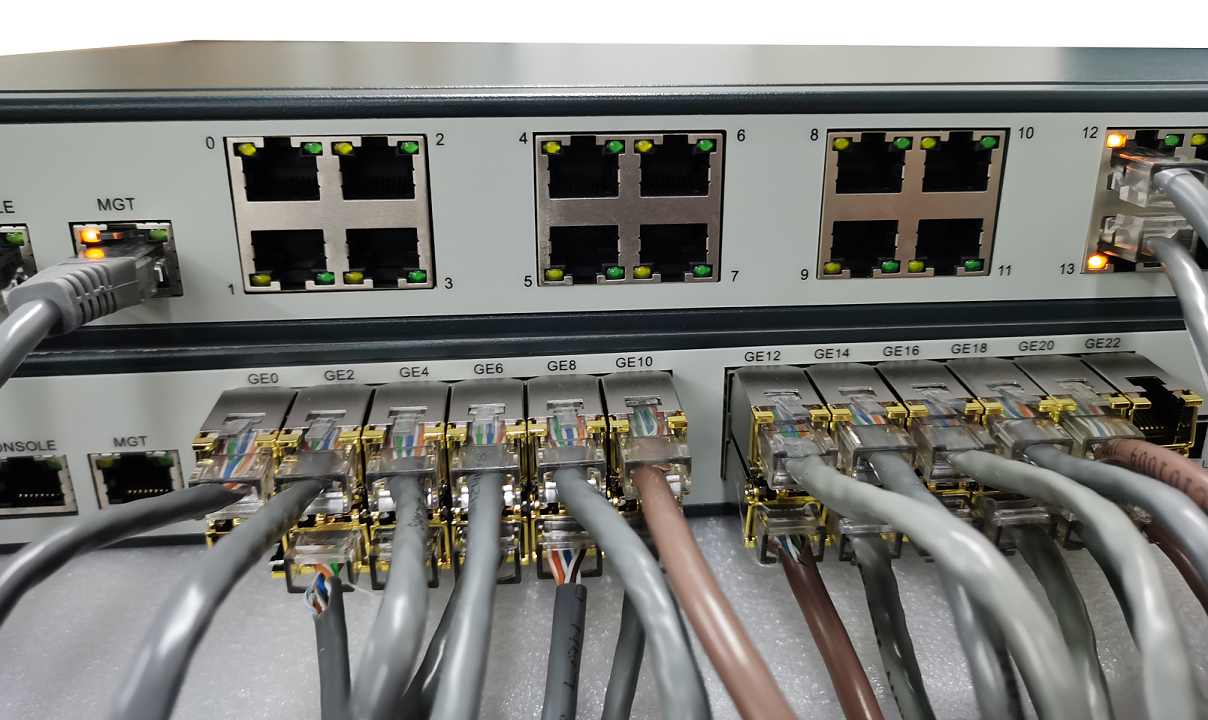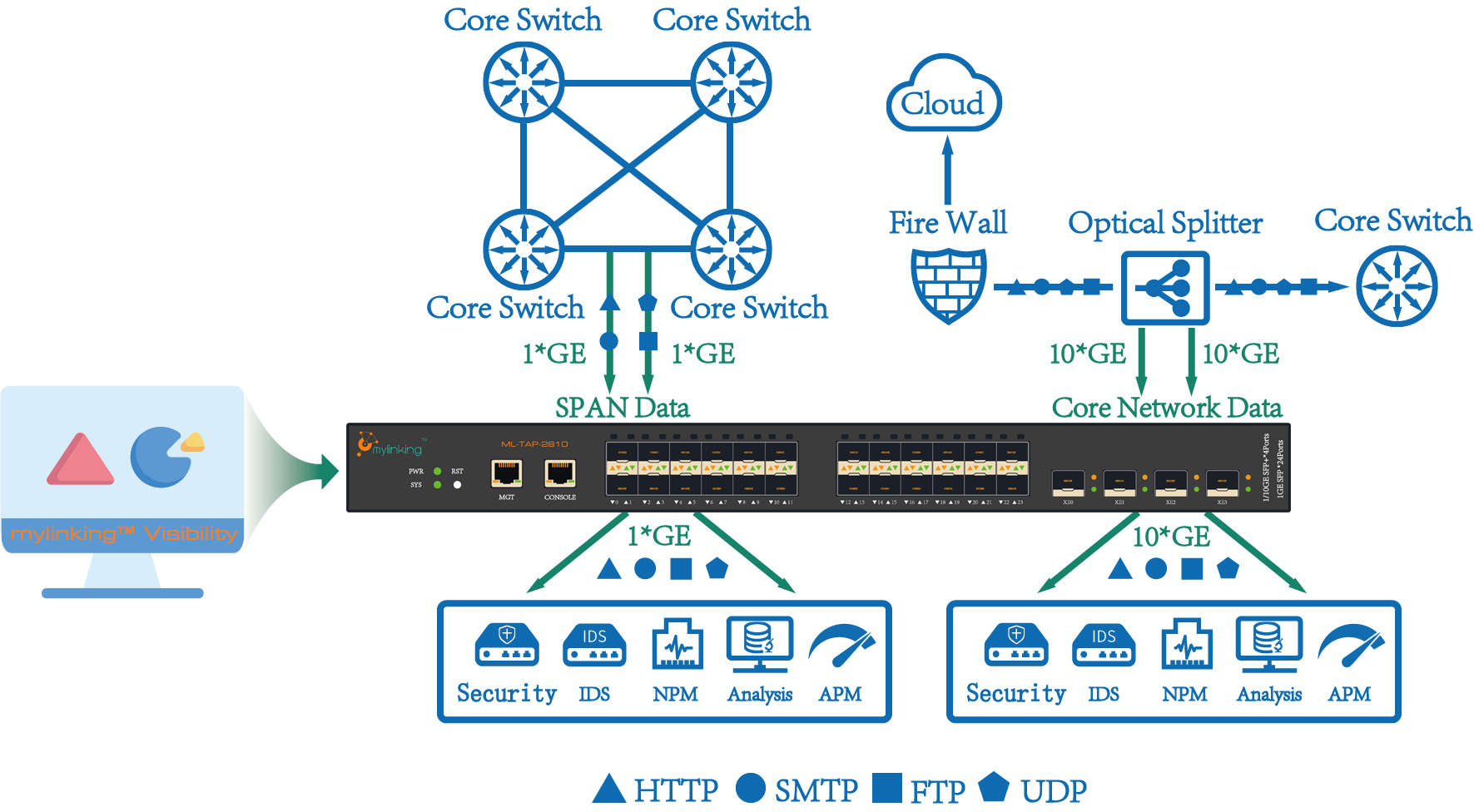A Network TAP(Test Access Points) is a hardware device for capture, accessing, and analyzing big data that can be applied to backbone networks, mobile core networks, main networks, and IDC networks. It can be used for link traffic capture, replication, aggregation, filtering, distribution, and load balancing. A Network Tap is often passive, whether optical or electrical, that creates a copy of network traffic for monitoring and analysis purposes. These network tools are installed into a live link in order to gain insight into the traffic moving across that link. Mylinking offer the full solution of 1G/10G/25G/40G/100G/400G network traffic capture, analytics, management, monitoring for inline security tools and out-of-band monitoring tools.
Powerful features and functions performed by the Network Tap include:
1. Network Traffic Load balancing
The Load balancing for large-scale data links ensures the accuracy and integrity of processing on back-end devices and filters unwanted traffic through configurations. The ability to accept incoming traffic and distribute it efficiently to multiple different devices is another feature that advanced packet brokers must implement. NPB enhances network security by providing load balancing or traffic forwarding to relevant network monitoring and security tools on a policy-based basis, increasing the productivity of your security and monitoring tools and making life easier for network administrators.
2. Network Packet Intelligent Filtering
NPB has the ability to filter specific network traffic to specific monitoring tools for efficient traffic optimization. This feature helps network engineers filter actionable data, providing the flexibility to precisely direct traffic, not only improving traffic efficiency, but also helping with speed event analysis and reducing response times.
3. Network Traffic Replication/Aggregation
By aggregating multiple packet streams into one large packet stream, such as conditional packet slices and timestamps, to make security and monitoring tools work more efficiently, your device should create a single unified stream that can be routed to monitoring tools. This will improve the efficiency of monitoring tools. For example, the incoming traffic is replication and aggregated through GE interfaces. The required traffic is forwarded through the 10 gigabit interface and sent to the back-end processing equipment; For example, 20 ports of 10-GIGABit (the total traffic does not exceed 10GE) are used as input ports to receive incoming traffic and filter the incoming traffic through 10-Gigabit ports.
4. Network Traffic Mirroring
The traffic to be collected is backed up and mirrored to multiple interfaces. In addition, unnecessary traffic can be shielded and discarded according to the delivered configuration. On some network nodes, the number of collection and diversion ports on a single device is insufficient due to the excessive number of ports to be processed. In this case, multiple Network taps can be cascaded to collect, aggregate, filter, and load balance traffic to meet higher requirements.
5. Intuitive and easy to use GUI
The preferred NPB should include a configuration interface -- a graphical user interface (GUI) or command line interface (CLI) -- for real-time management, such as adjusting packet flows, port mappings, and paths. If NPB is not easy to configure, manage, and use, it will not perform its full function.
6. Packet Broker Cost
One thing to keep in mind when it comes to the market is the cost of such advanced monitoring equipment. Both long - and short-term costs can vary significantly, depending on whether different port licenses are available and whether packet brokers accept any SFP modules or only proprietary SFP modules. In summary, an efficient NPB should provide all of these features, as well as true link-layer visibility and microburst buffering, while maintaining high availability and resilience.
Besides, the Network TAPs can realize the Specific Network Business Functions:
1. IPv4/IPv6 seven-tuple traffic filtering
2. String matching rules
3. Traffic replication and aggregation
4. Load balancing of traffic
5. Network Traffic mirroring
6. Timestamp of each packet
7. The packet deduplication
8. Rule filtering based on DNS discovery
9. Packet processing: slicing, add, and delete the VLAN TAG
10. IP fragment processing
11. The GTPv0/ V1 / V2 signaling plane is associated with the traffic flow on the user plane
12. The GTP tunnel header removed
13. Support MPLS
14. GbIuPS signaling extraction
15. Collect statistics on interface rates on the panel
16. Physical interface rate and SINGLE-fiber mode
Post time: Apr-06-2022






